Harley Wong | Artsy
Ghanaian artist Amoako Boafo has experienced a meteoric rise in the art world over the past year. Known for large-scale portraits of Black subjects rendered in bold, gestural strokes, Boafo has only gained momentum in 2020. Recently, in April 2020, he donated a painting, Aurore Iradukunda (2020), to an online benefit auction supporting the Museum of the African Diaspora during the COVID-19 pandemic.
The painting sold in early May for $190,000, nearly six times its $35,000 estimate.
Meanwhile, Boafo, who just celebrated his 36th birthday, has been busy in the studio with a new body of work. Currently living in his hometown of Accra, Ghana, he’s preparing for his first solo exhibition with Mariane Ibrahim Gallery, which was originally scheduled to open in June, but has been postponed to September due to COVID-19.

The Rise of the African Multinational Enterprise: The most authoritative book on private enterprise in Africa. Get a Copy from SPRINGER
In his work, Boafo celebrates Blackness in all its multitudes, as his sitters shine from backgrounds painted bright yellow or emerald green. “I wanted to paint the Black diaspora, or Black people, the way I see them,” Boafo said in a recent interview. In Kofi (2019), for example, a man looks out at the viewer inquisitively, his head cocked to the side with a slight smile on his face.
The finger-painted swirls of blue, brown, and pink that make up the sitter’s face pulsate, contrasting with the smooth electric blue that surrounds him. Boafo’s signature is easily overlooked on the collar of the man’s black turtleneck, but the artist’s hand is apparent throughout. Across his work, Boafo inserts admirable members of the African diaspora into traditions of European portraiture, with a distinctive, contemporary style of his own.
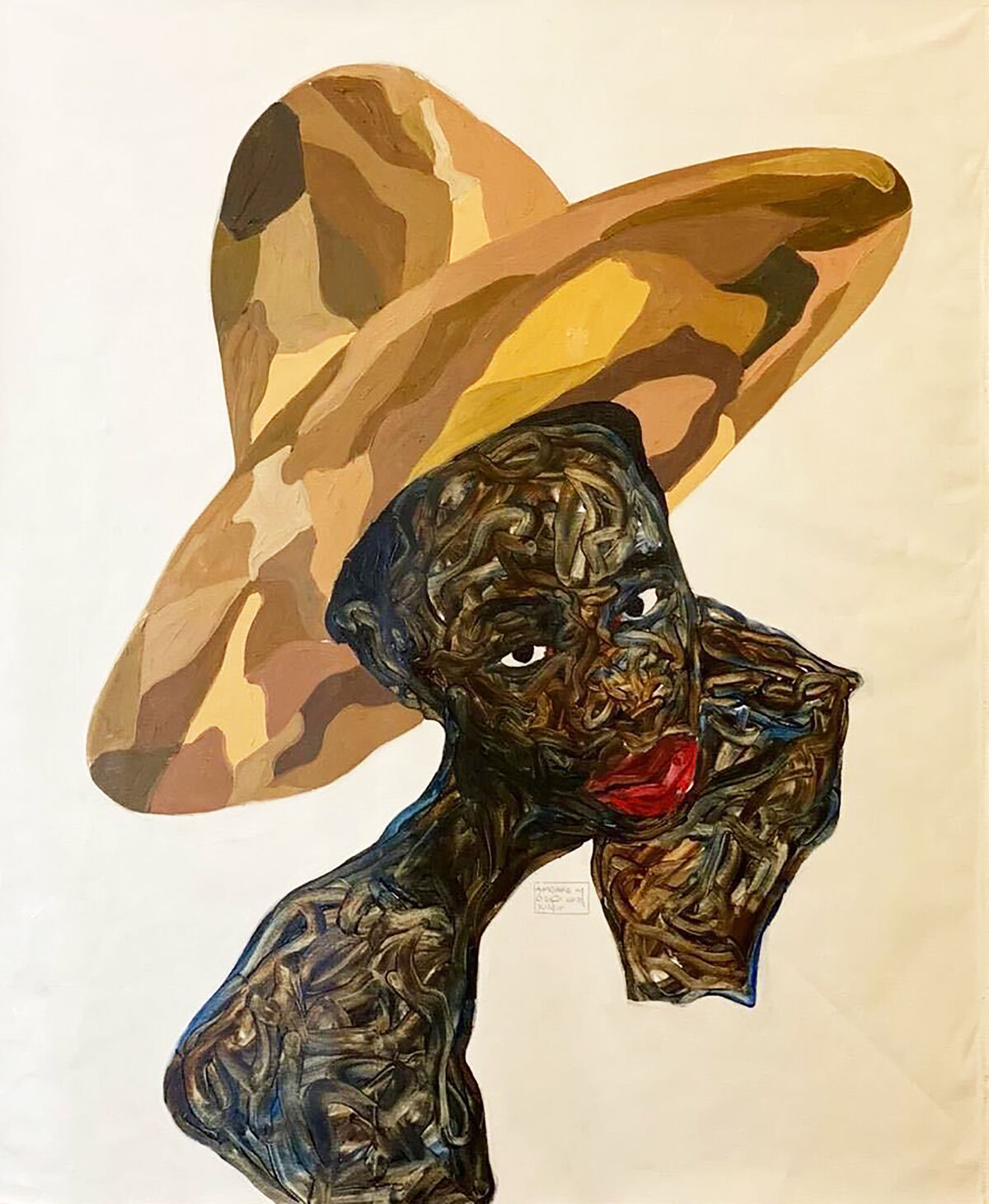
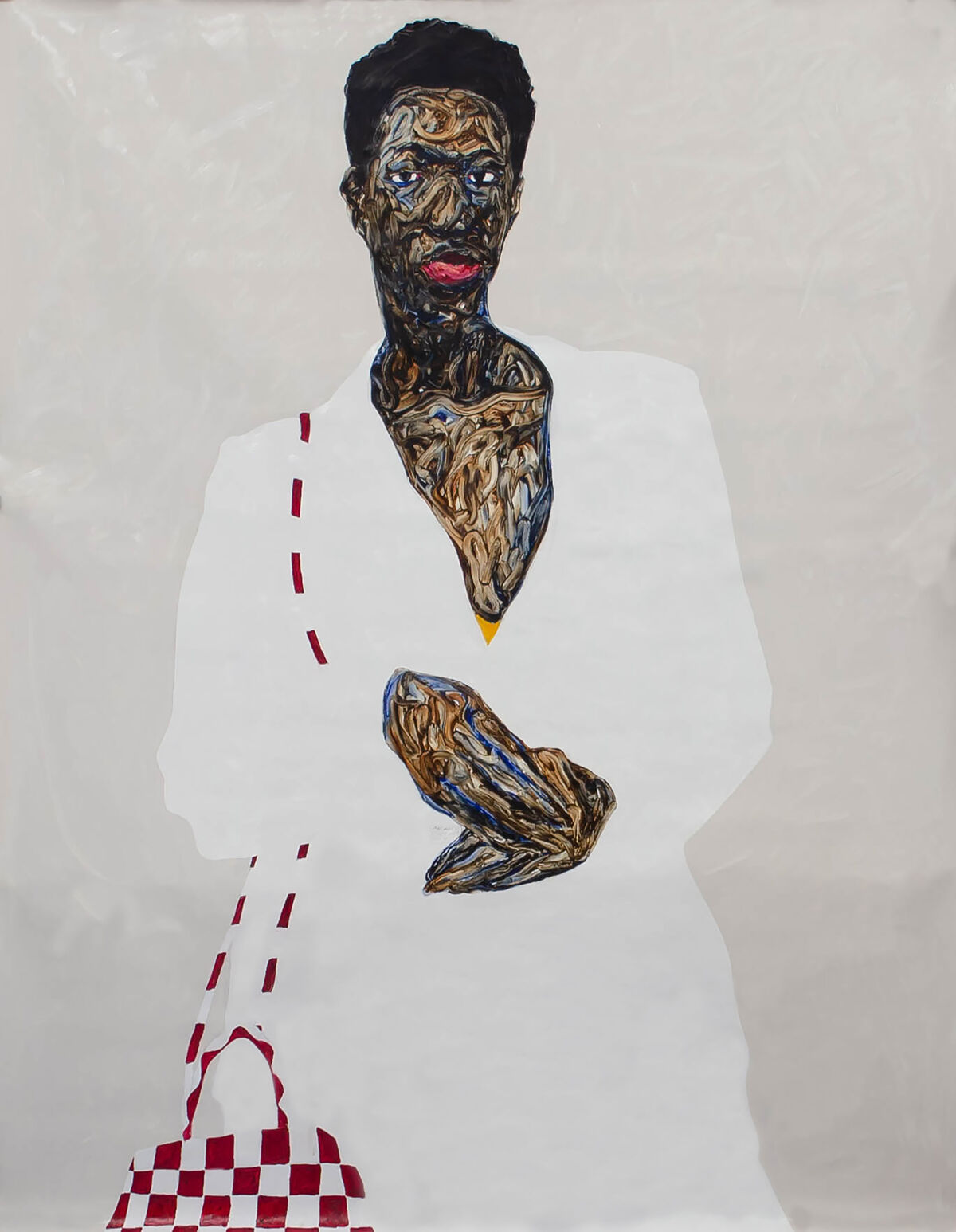
Using his fingers to paint his subjects’ bodies and brushes for their clothes and the background, Boafo has diverged from the academic traditions he learned at the Ghanatta College of Art and Design in Accra. “I know how to use a brush—my precision, color, arrangement, everything is accurate. I have so much control,” Boafo explained.
“I got to a point where I wanted more expressions, and in order to do that, I had to use tools that I don’t have control over.”
Boafo first used his fingers to paint when his friend asked him to be in a music video; at the time, he was still primarily using brushes. “I didn’t want to show my technique on camera, so I did a quick sketch beforehand, and then I used my fingers during the video,” Boafo recalled.
“After the video, when everyone had left, I saw some elements in the painting that I wanted in my work.” Boafo would revisit this method around 2017, while pursuing his MFA at the Academy of Fine Arts Vienna.
Confronting body politics in Vienna
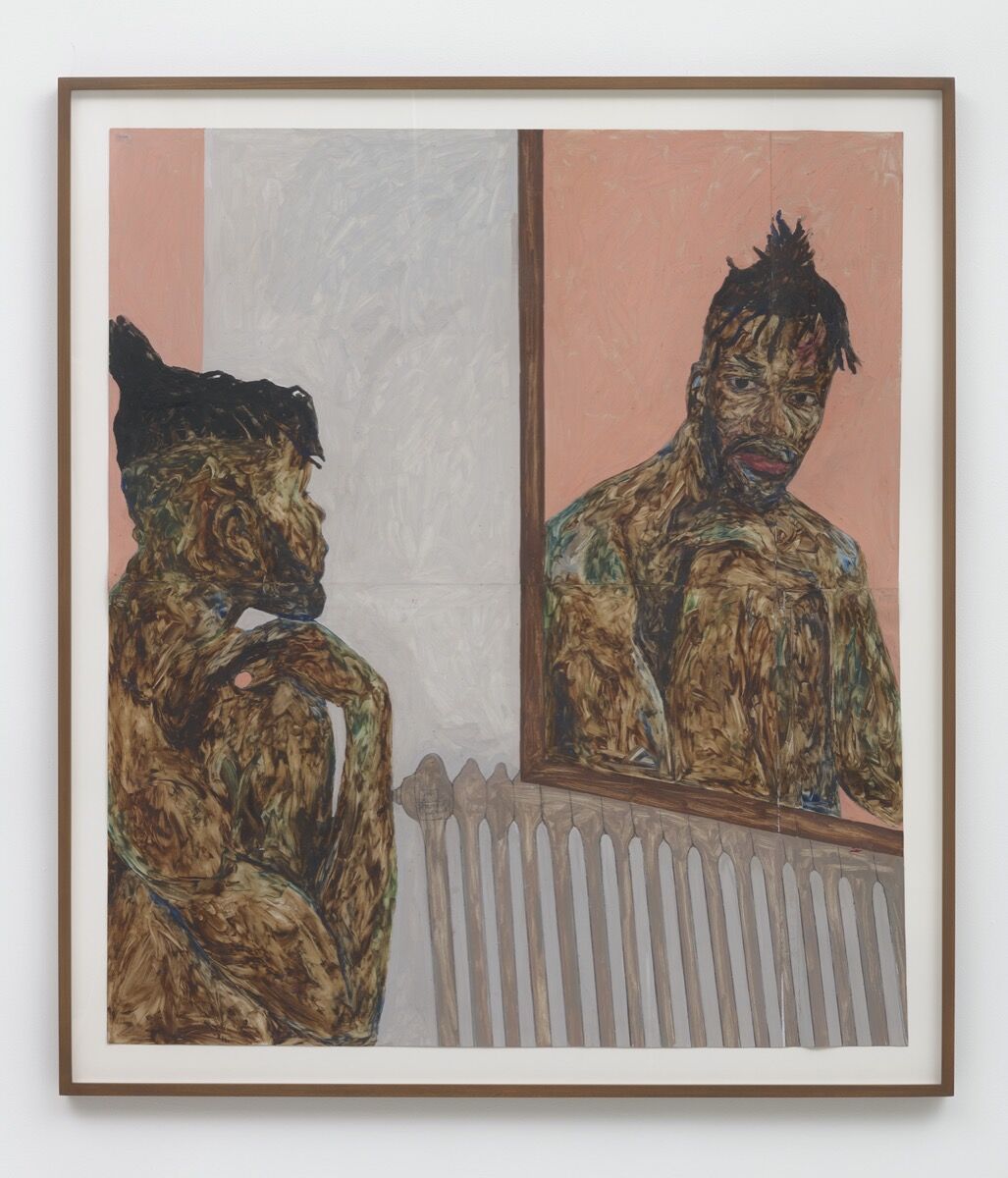
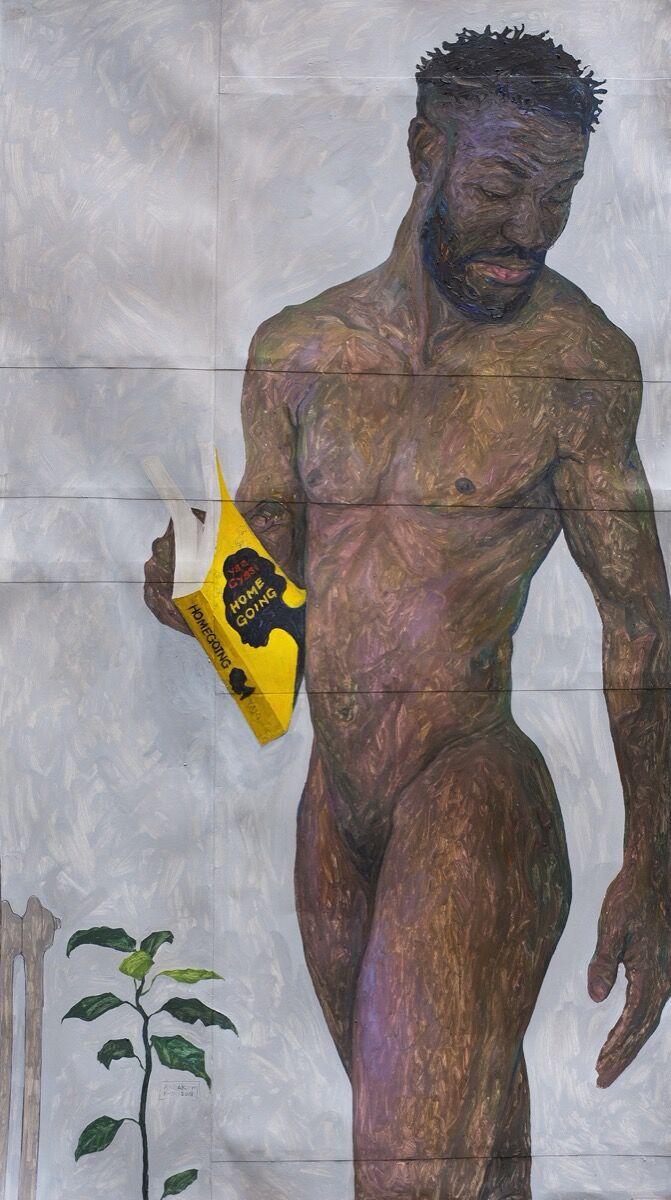
Boafo relocated to Vienna in 2014 to join artist Sunanda Mesquita, who is now his wife. Seeking a more robust art scene, he was initially optimistic about his prospects in the new city. “I thought that Europe, or the West more broadly, is more open to painting—that it’s a career that your parents will not discourage you from going into,” Boafo said. “But then when I arrived, I had a very difficult time because spaces rejected me, saying they don’t show African painting.” Moving from a predominantly Black country to a white one, Boafo became hyperaware of the ways Black people are perceived and treated in white spaces. He channeled his frustrations into “Body Politics,” the series of paintings that would lead to his first big break as an artist.One such work, Reflection 1 (2018), is a self-portrait of the artist sitting naked with his knee raised to his chest, gazing at his mirrored reflection. It portrays a tender moment of introspection; a glimpse, perhaps, into Boafo’s attempts to reconcile with the stereotypes pushed onto him. With his face turned away from the viewer, we can only see Boafo through his reflection.In another piece from “Body Politics,” Homegoing (2018), a Black man steps forward in a dynamic contrapposto pose and looks downward like the Farnese Hercules. Instead of a flayed lion skin under his arm, Boafo’s protagonist carries a copy of Yaa Gyasi’s Homegoing (2016). Covering approximately 250 years of familial history between two half-sisters, the novel is set in both Ghana and the United States; its title refers to the belief that death allowed the spirits of enslaved peoples to return to Africa. Like Gyasi, Boafo prioritizes the rich and multifaceted stories of the African diaspora, centering people who have long been left on the margins of painting.
Celebrating the Black diaspora
Fellow artist Kehinde Wiley was moved by “Body Politics,” as well as Boafo’s “Detoxing Masculinity” series, when he discovered the artist’s work on Instagram. Wiley not only bought works by Boafo, but also recommended him to Wiley’s Los Angeles gallery, Roberts Projects.
The gallery reached out to Boafo and organized his first solo exhibition in the United States entirely over email. The show opened at Roberts Projects in L.A. in January 2019.Titled “I See Me,” the exhibition featured works from Boafo’s ongoing series “Black Diaspora.”
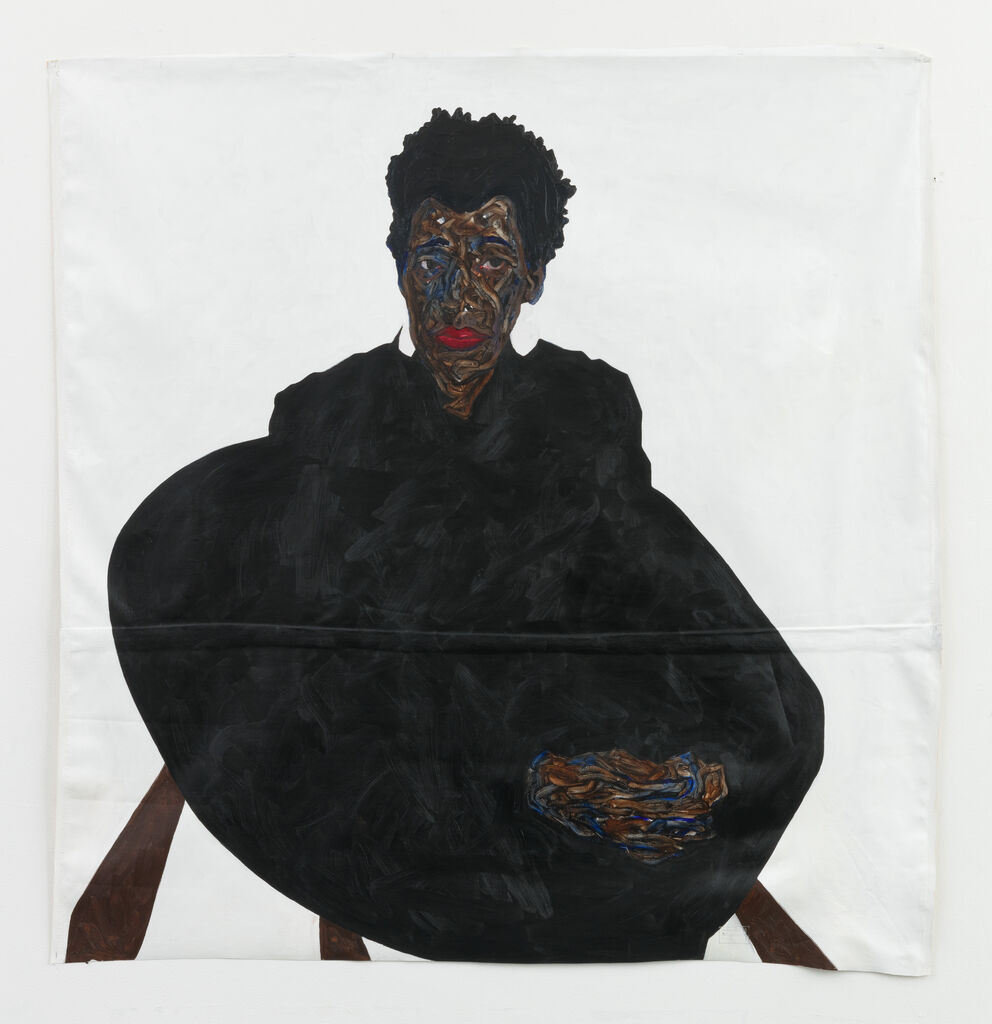
Lorraine O’ Grady, 2019
Roberts Projects
In these works, Boafo pivoted his attention to celebrating individuals of the African diaspora whom he admires. Ranging from friends to strangers, Boafo’s subjects occupy the elevated space of Viennese portraiture, drawing on Gustav Klimt’s commanding scale and Egon Schiele’s dynamic brushwork.
“I normally paint characters that inspire me,” Boafo explained, noting that he portrays people who have a voice—people who lift up others—as well those who are voiceless.
A frequent subject in “Black Diaspora” is Thelma Golden, director and chief curator of The Studio Museum in Harlem, who has spent decades advocating for Black artists. Boafo’s paintings engage in similar work, creating material space for others through portraiture and expanding the artistic possibilities of portraying Black experiences.
The art market takes notice
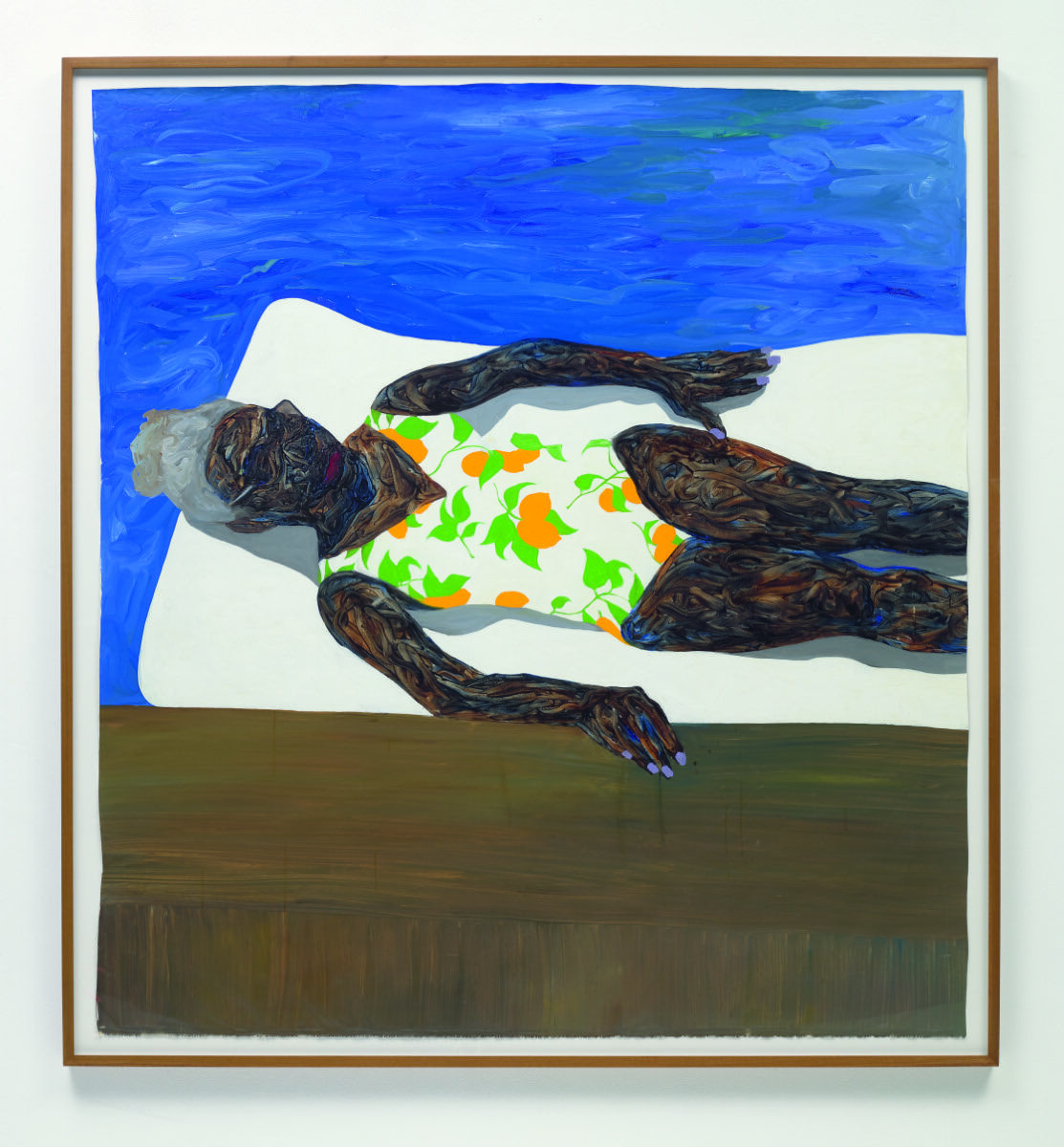
By December 2019, Boafo had caught the attention of esteemed collectors Don and Mera Rubell, who named him the first artist in residence at the newly opened Rubell Museum. At the same time, Boafo’s works were featured at Art Basel in Miami Beach with Mariane Ibrahim. The solo booth of works priced between $15,000 and $45,000 sold out.
In September of that year, Ibrahim had also exhibited Boafo’s work at Expo Chicago, where the portrait Steve Mekoudja (2019) was acquired by the Hessel Museum of Art.While Boafo saw immense success in the primary market in 2019, in February 2020, one of his paintings reached the secondary market.
The piece, The Lemon Bathing Suit (2019), had only been completed eight months before; it depicts Boafo’s friend’s mother floating in a swimming pool. Originally priced at $25,000, it was first sold to Stefan Simchowitz with a 10 percent discount.
Simchowitz—whom the New York Times once called “The Art World’s Patron Satan”—previously attempted to acquire Boafo’s work directly from the artist, but was turned away. He purchased The Lemon Bathing Suit from Jeffrey Deitch’s 2019 summer group show, when the work was consigned to the gallery by Roberts Projects.
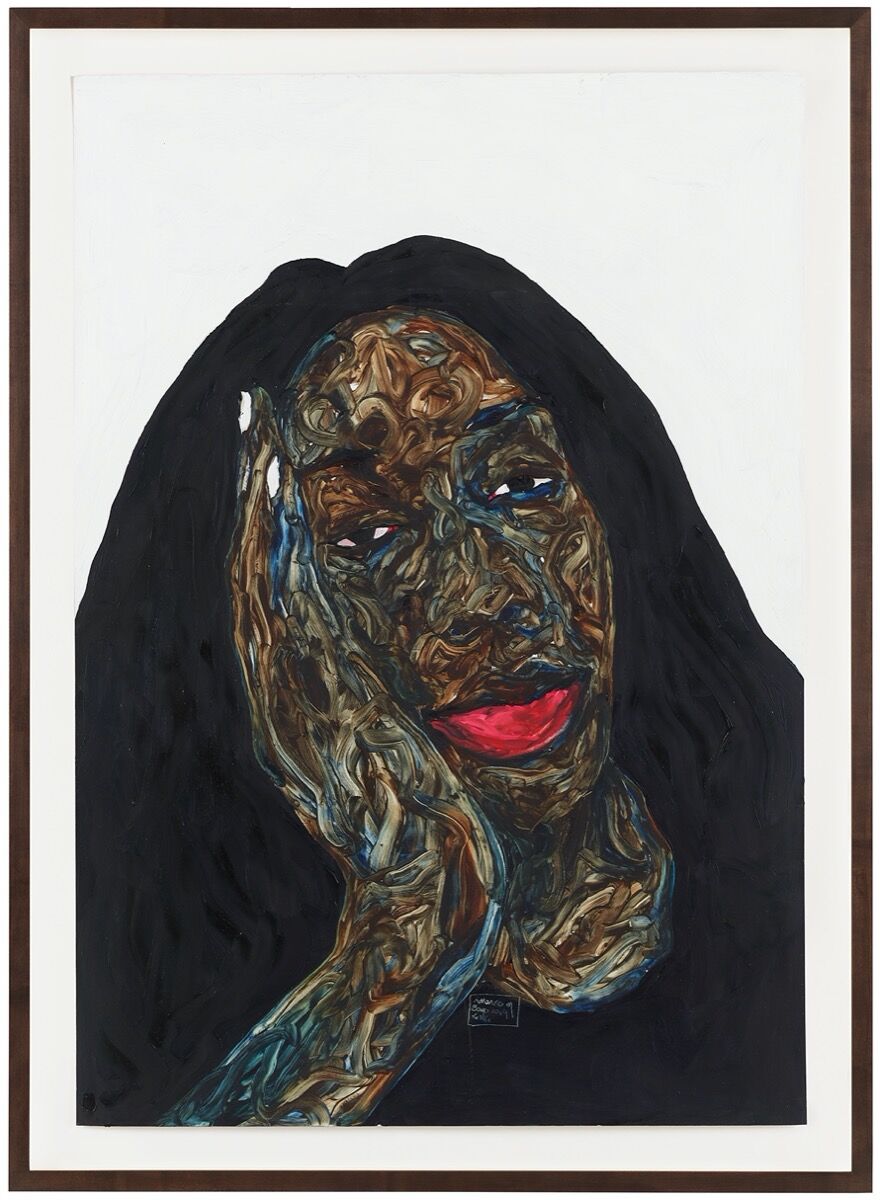
In February 2020, Simchowitz sold the work at Phillips’s 20th-century and contemporary art evening sale in London for £675,000 ($881,550), smashing its estimate of £30,000–£50,000 ($38,700–$64,500).
Amoako Boafo, Sleepy Lady, 2019. Courtesy of Phillips.
Amoako Boafo, Self Portrait, 2019. Courtesy of Sotheby’s.Boafo is one of several artists impacted by the growing trend of collectors flipping work by young Black artists; others include Derek Fordjour, Nina Chanel Abney, Jordan Casteel, and Tschabalala Self.

“He wants to make profit from it.…I want to have longevity,” Boafo told Bloomberg prior to the auction. “I am not so much focused on the money. If I get museum placement and shows, I am guaranteed longevity.”When we spoke this May, Boafo noted that the February auction made him more cautious about who purchases his work, and understandably so.
This month alone, Boafo had three works on paper head to auction. One piece, Sleepy Lady (2019), sold for £106,250 ($130,154) at Phillips as part of “Shaping the Surface: Online Auction”; it had an estimate of £15,000–£20,000 ($18,466–$24,622). And even though the painting was completed just last year, this is its third owner.
On May 22nd—the day after the Phillips sale concluded—Boafo’s Self Portrait (2019) went to auction at Sotheby’s. At the time of writing, the current bid is £60,000 ($73,105), already eclipsing the estimate of £20,000–£30,000 ($24,434–$36,651), well before the auction closes on May 28th. And on May 26th, Boafo’s Cobinnah with Yellow Nails (2019) went to auction in Phillips’s sale “connect / reflect / COLLECT a selection of contemporary art,” with a presale estimate of $25,000–$35,000. Within the first few hours, the painting has already received four bids, reaching $30,000.
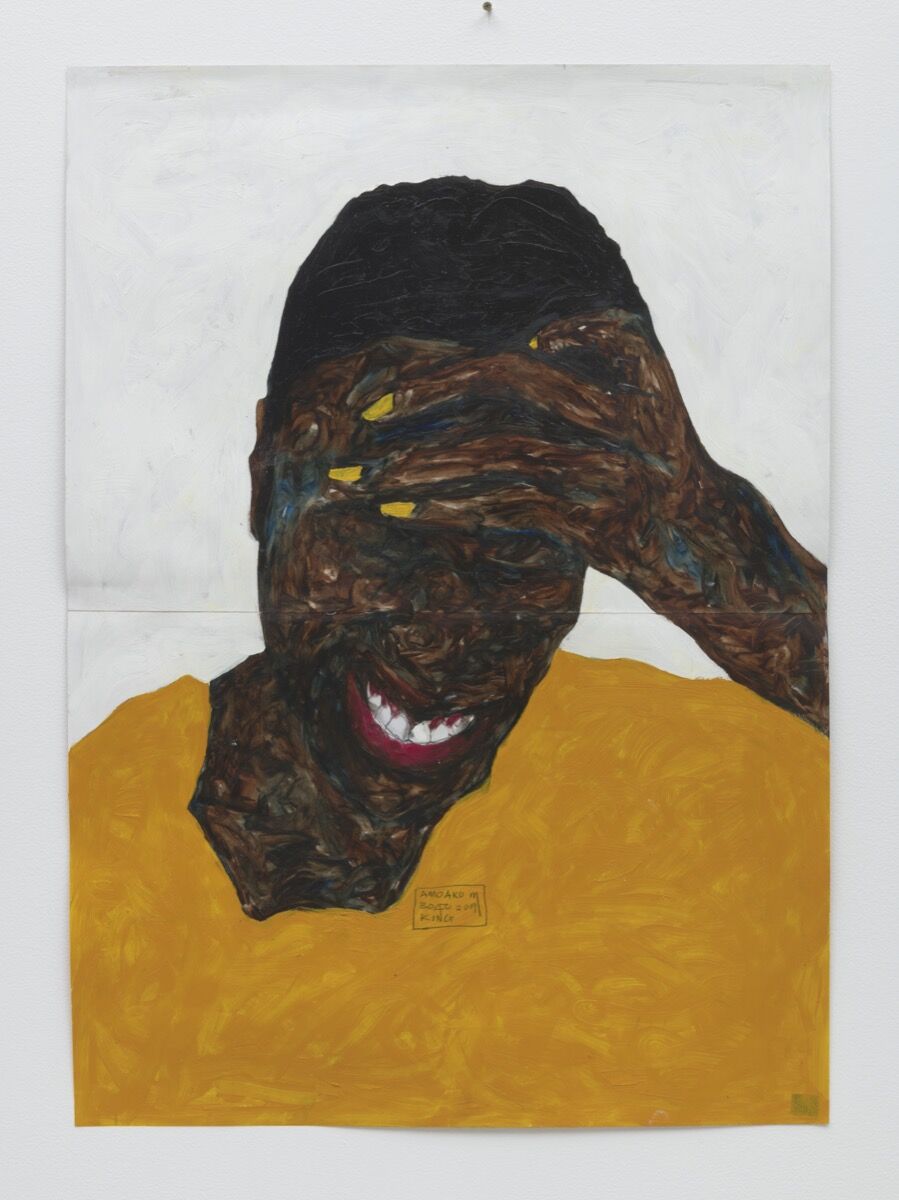
Amoako Boafo, Cobinnah with Yellow Nails, 2019. Courtesy of Phillips.Amoako BoafoSteve Mekoudja, 2019Mariane Ibrahim GalleryPrior to this year, Boafo’s work had only gone to auction as part of charity benefits. “I try to do charities every year,” Boafo said, noting that he typically gives one or two paintings to benefit auctions annually. His first cause in 2020 went towards San Francisco’s Museum of the African Diaspora (MoAD), which, in the wake of COVID-19, was forced to lay off 7 of its 18 staff members and reduce hours for its remaining staff after temporarily closing its doors. The online auction, “MoAD: Diaspora Unite! Artists of African Descent Benefit Auction,” which was hosted on Artsy, raised over $450,000—a significant portion of which was driven by Boafo’s piece, Aurore Iradukunda.
The painting features community organizer Aurore Iradukunda, who works to elevate the stories and experiences of Black youth in Canada. Boafo’s rendition—based on a photograph by Yannis Davy Guibinga that was commissioned by Apple for Black History Month—depicts Iradukunda looking over her shoulder at the viewer.
“I like the character she possesses,” Boafo said. “It’s the self-confidence in the picture that led me to paint her.” Considering Iradukunda’s own work, it feels fitting that the proceeds of her portrait would support one of the few museums in the world dedicated exclusively to arts of the African diaspora
This is only the latest demonstration of Boafo’s dedication to the Black community. In 2013, Boafo, Mesquita, and historian Jaqueline Ejiji founded WE DEY, an art space that promotes the work of Black, Indigenous, and people of color in Vienna. He’s also currently working to start an artist residency in Accra, using his newfound resources to support the local arts community in his hometown.
“If there had been more spaces in Ghana, I wouldn’t have thought of coming to Europe,” Boafo told Collectors Agenda. For now, Boafo is in his Accra studio preparing for his show with Mariane Ibrahim. Titled “I Stand By Me,” the exhibition will feature new works marked by the artist’s experimentation with photo transfer.
“It’s something that I started early last year, because I wanted different elements and textures in my work,” Boafo said. “Most people know my work to be this expressive face or figure with complementing flat colors. I wanted to do something different, so I started with the transfer technique.”
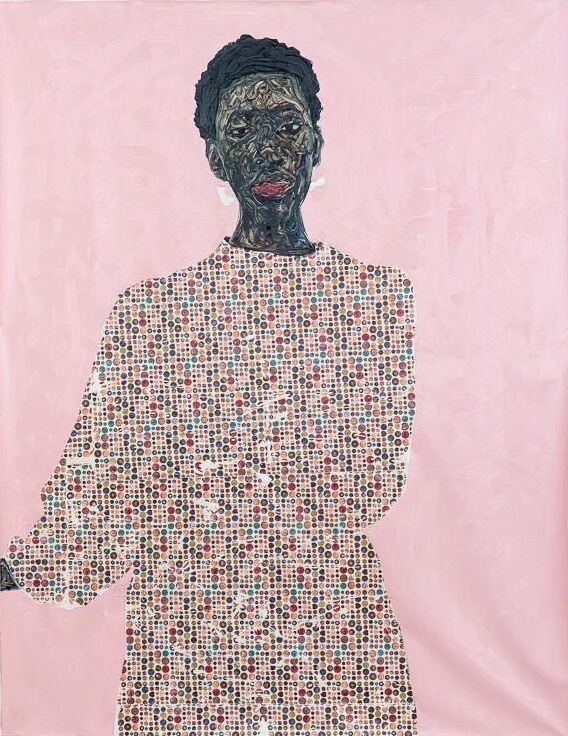
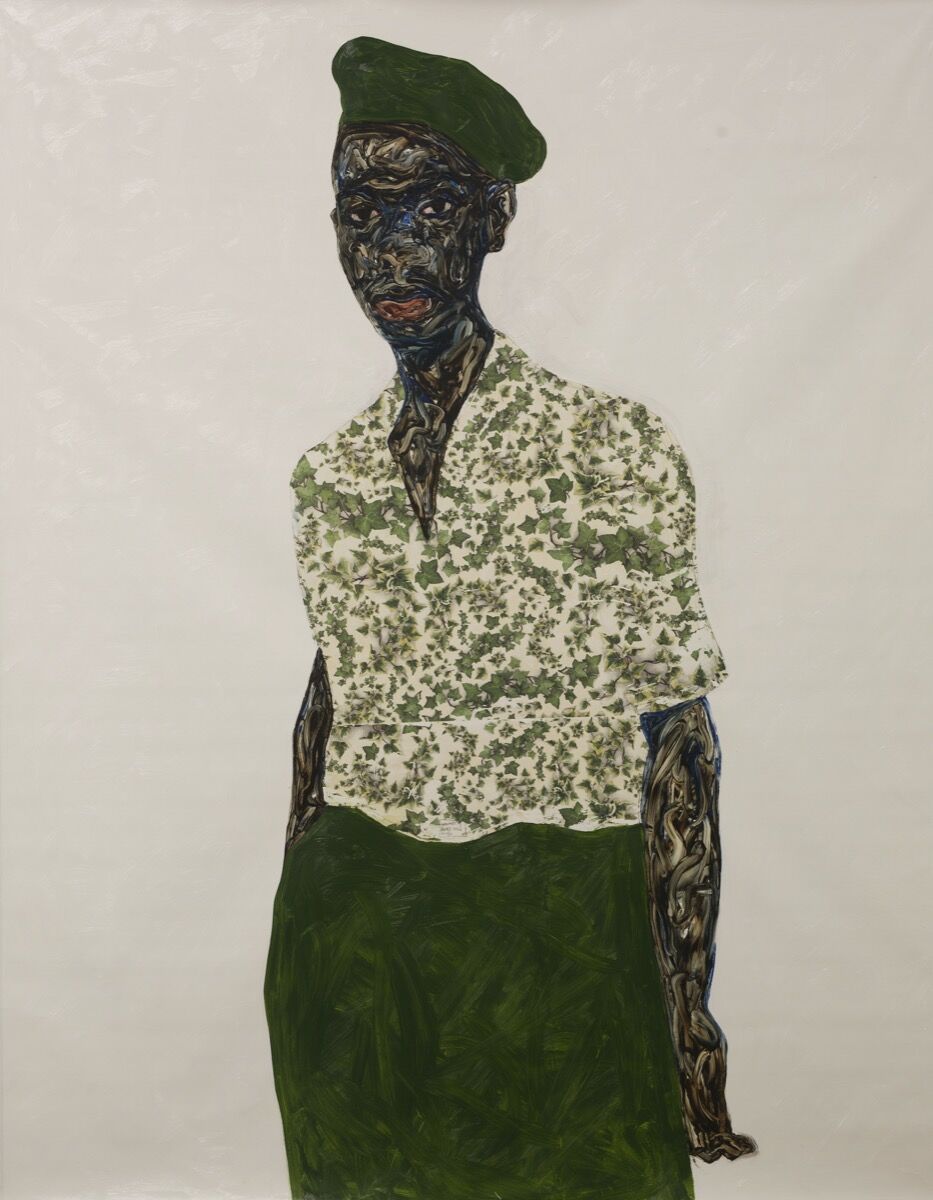
Amoako Boafo, Green Beret, 2020. Courtesy of the artist and Mariane Ibrahim.One piece in the exhibition, Green Beret (2020), shows a slender Black man wearing dark green pants and a matching beret. The title of the portrait shares its name with the United States Army Special Forces, but placed on the head of a Black man, the beret takes on additional meaning in reference to the Black Panther Party. The figure doesn’t wear camouflage or a leather jacket, but instead a loose V-neck shirt speckled with ivy leaves, transferred from European wallpaper.Opening less than two years after “I See Me” at Roberts Projects, “I Stand By Me” shows a slight change in focus. While “I See Me” sought to expand the possibilities of portraiture through focusing on members of the African diaspora, “I Stand By Me” is colored by the artist’s success in developing a recognizable style and securing a place in the art world. “With ‘I Stand By Me,’ I think I will have to take a strong stand and validate myself,” Boafo said, “while changing, decoding, creating new norms.”
Read from source Artsy
